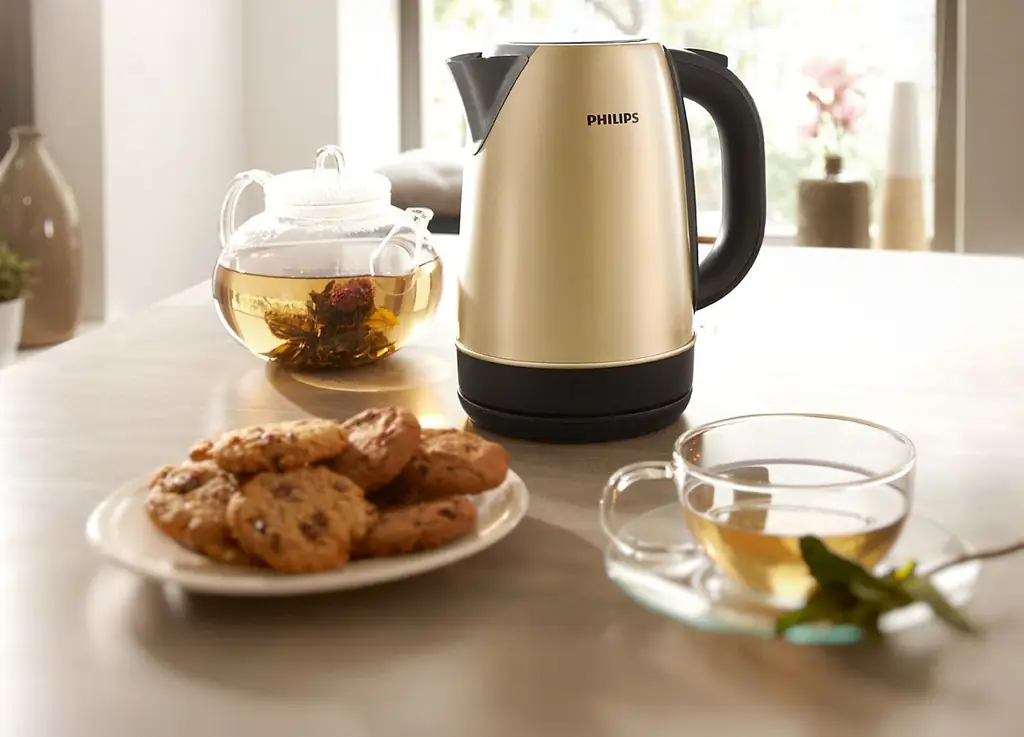
Table of contents:
- Author Bailey Albertson [email protected].
- Public 2023-12-17 12:53.
- Last modified 2025-01-23 12:41.
Effective tips for descaling all types of kettles

Tea drinking has long become familiar to us. And every house has a favorite kettle in which you boil water. Whatever it is: enamel, metal, electric, scale will certainly appear in it over time, even if you use expensive filters. This will definitely render your kettle unusable. To prevent this from happening, we'll show you how to descale your kettle quickly, easily and cheaply.
Content
- 1 Can limescale deposits be avoided?
- 2 Methods of struggle: folk remedies
- 3 A few more cleaning methods
- 4 Teapots
- 5 What can help you cope with scale?
- 6 Remove rust, smoke and grease
- 7 Video about descaling kettles
Can limescale deposits be avoided?
First, you need to understand what the scale is formed from. These are salts and minerals that are necessarily contained in tap water, and when heated, they disintegrate and settle on surfaces in the form of limescale. The harder the water, the more intensively scale will form, and additional softening will only delay the unpleasant moment, but will not get rid of it.
In an ordinary teapot - enameled or metal, the plaque settles on the bottom and inner walls, which causes rust, corroding the metal. In electric kettles, scale accumulates on the heating element in contact with water, which leads to its breakdown

Try to keep the kettle free from limescale
So that you do not have to clean your kettle for too long over time, or even replace it with a new one, use a few preventive tips:
- do not wait until the scale becomes too thick, less sediment is much easier to remove;
- rinse the kettle every day by wiping it with a sponge;
- use soft water for boiling, purified through a filter, and if there is such an opportunity - then purchased, in gallons;
- do not boil water again - this significantly increases scale;
- drain the water from the kettle after each boil, do not leave it overnight.
The kettle should be cleaned, even if it is brand new, just purchased. Factory processing leaves a plaque on the walls with an unpleasant odor. Having filled the container, boil the water several times until the smell disappears completely. 3 tablespoons of baking soda will help speed up the process - this will be enough to cope with the unpleasant aroma in one boil.
To combat the smell of plastic from a new electric kettle, bay leaves are perfect. Pour half the bag into a full container and boil twice. Then drain and rinse thoroughly in cold water.
Sugar will help remove the smell in a stainless steel kettle. Dissolve two pieces of refined sugar in boiled water and leave for half an hour. Then drain the water, pour in a new one and boil again.
Control methods: folk remedies
If a layer of scale does appear, urgently remove it. This will help you well with the tools that are always at your fingertips, and have been used for many years for such purposes as cleaning kitchen utensils:
- soda;
- vinegar;
- lemon acid.
Dilute citric acid in water in a ratio of 1 tablespoon to 1 liter. Boil for a few minutes (or bring to a boil if you have a plastic electric kettle), and leave for a few hours, or better overnight. The disadvantage of this method is that it is not very suitable for metal teapots: the surface becomes rough from the acid, lime sticks to it faster and holds stronger. But plastic surfaces will clean perfectly.
Dilute half a glass of vinegar or 3 teaspoons of the essence in 1 liter of water, boil, pour and rinse thoroughly. It is best to do this in a well-ventilated area so that the vinegar smell does not cause irritation. This method is absolutely not suitable for electric kettles.
Baking soda and acetic acid can help remove very thick limescale deposits. This method is also intended only for metal and enamel teapots. Pour in soda at the rate of 1 tablespoon per 1 liter of water and boil for half an hour. Drain, fill the kettle with clean water, add half a glass of vinegar and leave to simmer for another half hour. After that, clean the loosened plaque with a sponge and rinse.

Use proven household products for cleaning
And of course, household chemicals designed specifically for descaling. The most common - "Antinakipin" and "Silat", can be purchased at any specialized or hardware store. They are added to water in the amounts indicated in the instructions and boiled for several minutes, then drained. Such funds do an excellent job with the task, but they contain substances harmful to health, so rinse the kettle after them with special care.
A few more cleaning methods
It turns out that food can help us in effective cleaning of the kettle, and not exotic at all, but familiar to us, used daily in the kitchen.

Familiar foods can help you descale your kettle
- Plain lemon (preferably thin-skinned) does an excellent job of removing limescale. Its advantage over using citric acid is that it does not make the surface of metal teapots rough. Cut the lemon into several pieces, cover with water and boil for 10 minutes. Repeat if the precipitate has not dissolved well enough.
- You can use an apple in the same way, or replace it with apple cider vinegar: 1 cup to 1 liter of water.
- An excellent method, even known to our grandmothers, is the use of homemade pickle, for example, cucumbers or tomatoes. The brine contains enough citric or acetic acid to dissolve limescale. Pour it into a kettle, boil for 10 minutes, cool, and then wash the surfaces. This will also get rid of rust.
- If the scale in your metal or enamel teapot is still weak, then potatoes will help you. Rinse the cleanings thoroughly, put in a kettle, fill with water and bring to a boil. Leave it on for a couple of hours, and after the dishes have cooled down, wash them thoroughly. Peeling apples or pears will remove white scale salt.
- Carbonated drinks of famous brands (Pepsi, Coca-Cola, Fanta, Sprite) are popular not only for their taste, but also as a means for cleaning dishes from rust, burning and scale. The drink should be kept open until the gas has evaporated. After that, pour it halfway into the kettle and boil for 10-15 minutes if you have a metal kettle. Bring the electric one to a boil, then leave it for 15 minutes. Drain and rinse thoroughly.
Teapots
These small teapots made of glass, ceramic or plastic require no less maintenance than those in which we boil water. They also accumulate scale, especially in the spout and on the folds, and this plaque is very difficult to remove. And he, in turn, can lead to the appearance of extraneous unpleasant odors, which is simply unacceptable for tasty, aromatic and healthy tea.

Teapots also need maintenance
Use a method that will help get rid of both plaque and excess odor, and at the same time from harmful bacteria that are so fond of settling in third-party impurities. Boil water in a large saucepan, add 1 cup vinegar and 4 tablespoons of baking soda. Submerge the teapot in water for 20-30 minutes. If it is made of heat-resistant ceramic, then you can boil it. Rinse thoroughly and wipe dry. Excess odors and build-up plaque will go away.
If the sediment on the teapot is old, rub it with dry soda or fine salt after washing. You can also use regular sand.
What can help you cope with scale?







We remove rust, fumes and grease
Limescale is not the only nuisance that can happen to your kettle. Rust, solidified fat, burnt areas often appear on any kitchen surface, and dishes are no exception. And all these contaminants act to the detriment of helping each other: scale destroys metal surfaces, leading to rust and burning, fumes and rust attract fat to themselves and "fix" new scale. Therefore, if you really clean the kettle, then completely, saving it from all the troubles at once.
Rust should be cleaned up as soon as you notice signs of rust. Sprinkle a little washing or cleaning powder over the rusty stain and let sit for 20 minutes. Then wipe the problem area with a half potato. Then rinse the kettle thoroughly under running water.

Timely clean rust from the metal kettle
In addition to the fact that the fumes give the dishes an unaesthetic look, its layer, when heated, releases toxic substances. Therefore, the burnt kettle must be cleaned immediately.
- Use a household cleaner, this is the easiest option. Apply it to the surface and let it sit for 15-20 minutes, then rinse the kettle in water.
- Get a large pot that will fit the entire kettle. Prepare a solution: 10 liters of water, 100 grams of soda, 80 grams of silicate glue (you can replace it with grated laundry soap). Bring the saucepan with the solution and the kettle immersed in it to a boil, let cool. After that, clean the surface from carbon deposits with a sponge.
- A thin layer of external carbon can be easily removed with wet salt or a solution: 1 tsp. salt per 1 tbsp. vinegar.
- Activated carbon will cope with the fumes on the aluminum kettle. Crush 10-15 tablets and apply evenly to the wetted surface. After an hour, dry thoroughly and rinse with water.
If you don't want to use chemicals to remove grease from the kettle, use baking soda to wipe down the problem areas. In case of an advanced stage, a solution will help you:
- 1 tbsp vinegar;
- 1 tsp salt;
- 1 tsp soda.
Wipe dried fat with it and rinse.
Descaling teapots video
Of course, it is best not to wait for the problem to manifest itself, but to warn it. We hope that our tips will help you out of trouble with your favorite teapot. Share your methods with us in the comments. Comfort for your home!
Recommended:
How To Fix An Electric Kettle: How To Seal It, How To Repair It, If It Does Not Turn On, Etc. + Photos And Videos

Detailed instructions for repairing an electric kettle for those who are friends with a screwdriver and a multimeter. How to fix a cracked case. Tips and instructions
How To Clean The Microwave, Descale The Kettle And Remove Grease From The Stove Handles, Tidy Up Burnt Pots And Carry Out Other Cleaning

How to quickly carry out a general cleaning of the house: wash the microwave oven and stove handles from grease, descale the kettle, scrub burnt pots, etc
How To Clean A Washing Machine With Citric Acid From Limescale And Other Problems

A step-by-step process for cleaning the washing machine. Features of the effect of citric acid on scale
How To Choose An Electric Kettle: Rating Of The Best Models, What You Should Pay Attention To

Characteristics of electric kettles. Which one is better to choose: rating of popular models. Video and customer reviews
Canned Cucumbers With Citric Acid For The Winter: The Best Recipes Without Vinegar, Reviews Of Housewives

Benefits of harvesting cucumbers with citric acid over canning with vinegar. Step by step recipes with photos and videos. Hostess reviews
